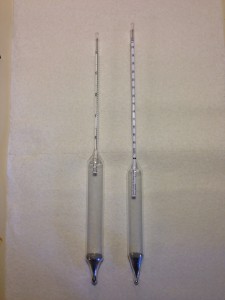 Brewers, especially new brewers, may wonder what the final gravity (FG) of their beer should be. Perhaps their barleywine stopped fermenting at SG 1.022 and they are wondering if it’s done or the fermentation is stuck. This is something the FG alone can’t tell you.
Brewers, especially new brewers, may wonder what the final gravity (FG) of their beer should be. Perhaps their barleywine stopped fermenting at SG 1.022 and they are wondering if it’s done or the fermentation is stuck. This is something the FG alone can’t tell you.
Established recipes frequently list an expected FG, and these should be a good estimate if you follow the recipe exactly. If, however, you’re formulating your own recipe — or modifying an existing one — the FG depends on three main variables. First, every yeast strain has a different range of apparent attenuation. Secondly,grain bills can be mashed to yield more or less fermentable worts. (Likewise, different malt extracts yield worts of differing fermentabilities.) And finally, some kettle adjuncts are more or less fermentable than wort made from mashed grains or dissolved malt extract. Table sugar (sucrose), for example, is 100% fermentable. In contrast, milk sugar (lactose) is not fermentable by brewers yeast. Although it may be possible to calculate a likely FG, you can determine experimentally what your FG will likely be with the forced fermentation test.
In a forced fermentation test, you take a small sample of chilled wort on brew day, aerate it thoroughly, and pitch an excessive amount of yeast to the sample. You then ferment the sample at a relatively high temperature. The sample should quickly ferment, yielding the likely FG of the actual beer days before the main batch of beer finishes. Knowing this result will let you know if your main batch of beer has a stuck fermentation or if it has reached the lowest FG it can, given the yeast strain and fermentability of the wort.
Forced fermentation tests are most useful when brewing very strong beers, or when using ingredients with unknown fermentabilities. When the fermentation of a big beer winds down, brewers often wonder if the fermentation is finished, or stuck prematurely. A forced fermentation can answer that question. If your actual FG is within a “gravity point” or two of the forced fermentation test, your beer is done.
If the FG is much higher than the FG of the forced fermentation test, you will want to rouse your yeast and raise the temperature of the main batch by a few degrees. Pitching more fresh yeast may also help. (See my article on dealing with stuck fermentations for more information.)
There are a lot of ways you can perform a forced fermentation test, most requiring no specialized gear whatsoever. The best way would be to incubate your sample in a temperature-controlled chamber in a shaker or on a stir plate. The temperature and constant movement of the fermenting sample would ensure that it finished quickly. However, you can perform the test simply by letting the sample sit in any sanitized container somewhere warmer than your main batch of beer. The fact that the sample was pitched at a very high rate will ensure that the forced fermentation test will finish in time to be useful. On Friday, I’ll post the nitty gritty details of a couple different ways to conduct this test. It’s really very straightforward — both in performing the test and interpreting the results — and it can take the worry out of bottling any big beer.
—
Related Articles

Speak Your Mind